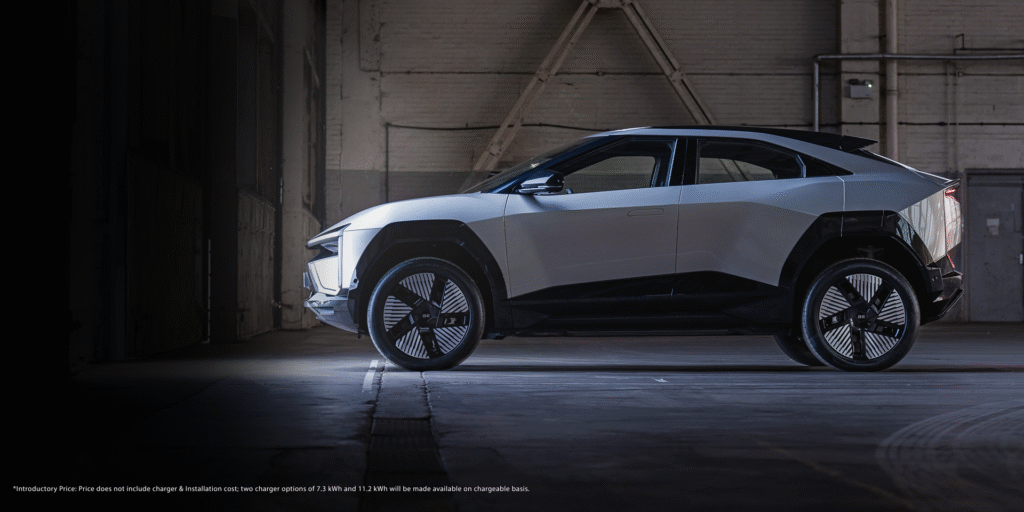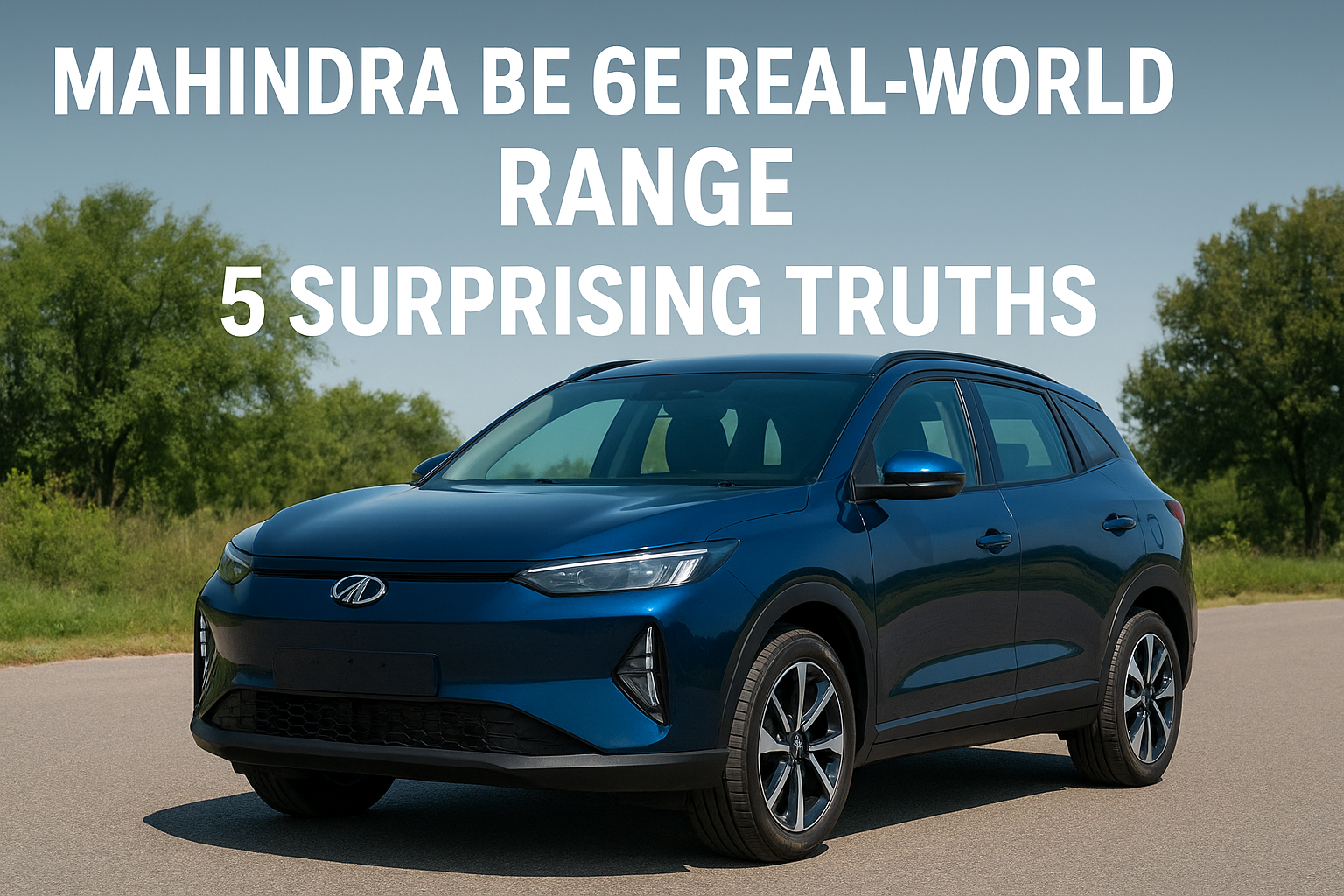Introduction
If you’ve been eyeing an electric SUV lately, one question always comes up: what is the real-world range on a full charge for Mahindra BE 6E? It’s one thing to read the claimed numbers and another to see how far it really goes in city traffic, heat, AC, hills, etc. This article peels back the numbers, specs, warranty, and what you can expect when the rubber meets the road.
Table of Contents
The real-world range on a full charge for Mahindra BE 6E
On paper, Mahindra claims that with the larger 79 kWh battery, the BE 6e can cover 682 km under the MIDC P1+P2 cycle. With the 59-kWh battery, the claim is about 535-557 km under similar MIDC conditions.
But in real life, the numbers are more modest. Tests and reviews show that under city conditions, with AC on, stop-and-go traffic, etc., the 79 kWh version delivers around 439 km on a full charge. On highways the same version gives about 459 km. Combine both city and highway use, and you’re looking at closer to 449 km. That’s still impressive, but noticeably lower than the 682 km claimed.
So, in practical usage, the real-world range on a full charge for the Mahindra BE 6E (79 kWh version) is likely to be somewhere between 430 and 460 km depending on climate, driving style, speed, terrain, etc. For the smaller battery, you’d expect less (often 300 to 400 km in mixed usage).
What is the battery capacity of the Mahindra BE 6E EV?
Mahindra offers the BE 6e with two battery capacities: 59 kWh and 79 kWh.
These are the usable energy storage numbers under ideal lab/certified test conditions. The 79-kWh pack is the higher-capacity variant aimed at giving maximum range; the 59 kWh is for lower cost, lower range, and lighter weight.
What is the battery specification of Mahindra BE 6E?
The specifications are:
- Type/chemistry: Lithium-iron-phosphate (LFP), using BYD’s blade cell technology.
- Powertrain: Rear-wheel drive (for now), with a compact “three-in-one” integrated powertrain (motor + inverter + transmission) for each battery option.
- Output: The 59-kWh version produces about 231-228 horsepower (PS), and the 79-kWh version about 286-281 PS, both delivering torque of 380 Nm.
- Charging specs: DC fast charging (20-80%) is possible in about 20 minutes using a 175-kW fast charger (with slight variations depending on battery size). AC charging options include an 11.2 kW AC charger (or 7.3 kW depending on the variant), with full charge times of ~6-8 hours or more for the batteries.
What is the battery life of the Mahindra BE 6E?
Battery life depends on many factors—usage, charging habits, and climate. But here’s what the information suggests and what you might expect.
Mahindra has tested the battery packs (both 59 kWh and 79 kWh) under severe conditions: lab tests, long-distance prototype driving, immersion, high temperature, etc. They claim a lifetime warranty (for first owners) and good durability.
Realistically, with moderate to good usage (not abusing fast charging often, not always pushing to full charge, and avoiding extreme heat without cooling), you can expect the battery to retain maybe 80-90% of its original capacity even after many years (say, 8-10 years or 150,000-200,000 km or more). After that, performance (range) will decline gradually. For many users, the battery will last well beyond the vehicle’s other wear and tear items.

Mahindra BE 6 Battery and Performance
With the 59-kWh battery, the BE 6e delivers a solid performance: quick enough acceleration, decent power, and good torque. With the 79-kWh battery, apart from increased range, you also get better punch—0-100 km/h in about 6.7 seconds in the 79-kWh version.
Performance is tied to battery capacity—not just for range but also for sustained speed, how well AC cooling works, how much regen you get, etc. A bigger battery means more buffer, less stress, and a better ability to maintain range under load (highway, AC, steep climbing). But also, more cost, weight, and possibly more energy consumed under certain conditions.
What is the cost of EV battery replacement?
This is one of the trickier things: Mahindra has not published a firm public figure for full replacement of the BE 6e battery pack in all variants. The replacement cost depends on battery size (59 vs. 79 kWh), labor, and how much is under warranty. Out-of-warranty battery replacement in large EVs tends to run into several lakhs (INR) of rupees.
From what is known for earlier Mahindra EVs (e.g., XUV400) and EV battery trends in India, replacing a large pack can cost somewhere near ₹5-10 lakh or more, depending heavily on capacity, supplier, and logistics. But for BE 6e, expect it to be on the higher side because of advanced pack tech and higher capacity. The lifetime warranty helps mitigate this cost risk substantially for owners who keep their car long-term.
What is the lifetime warranty on the Mahindra BE 6E battery?
Mahindra’s warranty policy for the BE 6e battery is generous, especially for first registered owners under private registration. The lifetime battery warranty covers both the 79 kWh and 59 kWh high-voltage packs for first owners.
If the vehicle is sold or changes ownership, then the warranty on the HV (high-voltage) battery is limited to 10 years or 200,000 km, whichever comes first, from the first-ever delivery date.
This means that as long as you’re the original owner and you meet private registration conditions, Mahindra backs the battery for its expected useful life. That gives a lot of confidence when thinking of range degradation, replacement cost, etc.
Which company’s battery is used in the Mahindra BE 6E?
The battery in the BE 6e uses BYD’s blade cell technology. Mahindra has partnered to use Blade LFP (Lithium Iron Phosphate) battery cells from BYD for its battery packs.
By using BYD Blade LFP, Mahindra achieves a safer, stable chemistry with better thermal performance, lower fire risk, and good cycle life. These traits help the “real-world range on a full charge for Mahindra BE 6E” stay closer to claims under favorable conditions because of reduced losses and better management.
Can we charge the Mahindra BE 6E at home?
Yes—you can charge the BE 6e at home with AC charging. The options offered include AC chargers (typical domestic or wall-box style) of around 11.2 kW and a lower 7.3 kW / 7.2 kW variant depending on what is bought or supplied.
Full charge times for the AC charging for the 59-kWh battery are about 6-8 hours (depending on charger power and house wiring); for the 79-kWh variant, a little more, maybe 8-11 hours, again depending on the charger.
For faster charging (DC fast chargers), you need to go to public or designated charging stations. DC fast 20-80% takes ~20 minutes for these battery packs.
So, home charging is viable, especially overnight, for daily commutes and reasonable usage.
Data Table: Stat Numbers & Sources
Here’s a table summarizing key stats and sources to help you eyeball claims vs. reality.
| Year | Stat | Source |
| 2025 | MIDC-claimed range for BE 6e (79 kWh): 682 km | Mahindra official specs |
| 2025 | WLTP range (79 kWh): 550 km | Official spec sources |
| 2025 | Real-world range (city, 79 kWh): 439 km | Autocar India test |
| 2025 | Real-world range (highway, 79 kWh): 459 km | Autocar India test |
| 2025 | Battery sizes: 59 kWh and 79 kWh | Mahindra spec sources |
Comparison Table: Benefits, Pros & Cons, Features
Here’s a “grapes-style” comparison that weighs what you gain vs. trade-offs, focusing on BE 6e battery & range aspects.
| Feature/Factor | Pros (Benefits) | Cons (Trade-offs) |
| Large battery (79 kWh) | Much higher claimed range (682 km MIDC), better highway real-world range, smoother performance under load | Higher cost, more weight, possibly slower charging at AC, more stress on infrastructure |
| Smaller battery (59 kWh) | Lower price, lighter weight, less strain on charging if AC/short circuits, probably less battery cost of replacing later | Reduced range (especially in long trips or on the highway), lower buffer in hot/hilly conditions |
| Blade LFP tech (BYD) | Better cooling, safer chemistry, good cycle life, less risk of thermal runaway | Lower energy density vs some NMC chemistries, so more pack weight/size for same range; possibly lower peak power for same mass |
| Fast DC charging (~20-80%) | Convenient for long trips, reduces charging time drastically | Requires publicly available chargers of suitable power; fast charging often degrades batteries more over long periods if used excessively |
| Home AC charging | Very convenient overnight, good for daily use, lower cost per km (electricity vs fuel) | Slower, may require installation of charging hardware, variable electricity rates, possibly higher AC loads in household wiring |
Conclusion
If you’re wondering about the real-world range on a full charge for the Mahindra BE 6E, here’s the summary:With the 79-kWh battery, expect something like 430-460 km in mixed or highway driving, less if it’s heavy city use, much AC, hilly terrain, or aggressive driving. The 59 kWh model will give less, but still enough for many daily drivers who aren’t doing long highway pushes every day.
The BE 6e’s battery specs, performance, warranty, and home charging ability make it a serious contender in the EV space. The lifetime battery warranty for first owners, together with BYD blade LFP tech, helps reduce worry over battery life and replacement cost.
If you’re considering buying one, think about how far you usually drive in a day, how often you take highway trips, where you’ll charge (home or public), and how much future degradation you’re okay with. Because once you decide battery size (59 vs 79), most other factors follow.

2 thoughts on “The Real-World Range on a full Charge for Mahindra BE 6E”